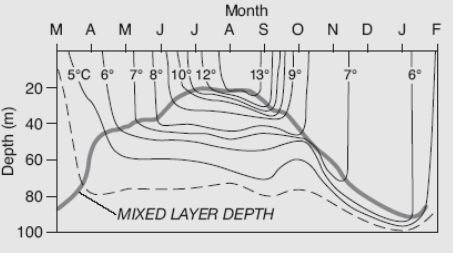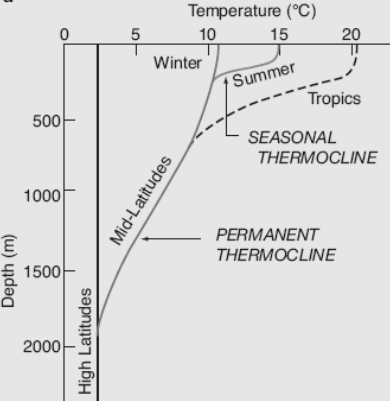|
Mixed Layer
The oceanic or limnological mixed layer is a layer in which active turbulence has homogenized some range of depths. The surface mixed layer is a layer where this turbulence is generated by winds, surface heat fluxes, or processes such as evaporation or sea ice formation which result in an increase in salinity. The atmospheric mixed layer is a zone having nearly constant potential temperature and specific humidity with height. The depth of the atmospheric mixed layer is known as the mixing height. Turbulence typically plays a role in the formation of fluid mixed layers. Oceanic mixed layer Importance of the mixed layer The mixed layer plays an important role in the physical climate. Because the specific heat of ocean water is much larger than that of air, the top 2.5 m of the ocean holds as much heat as the entire atmosphere above it. Thus the heat required to change a mixed layer of 2.5 m by 1 °C would be sufficient to raise the temperature of the atmosphere by 1&n ... [...More Info...] [...Related Items...] OR: [Wikipedia] [Google] [Baidu] |
Thermocline
A thermocline (also known as the thermal layer or the metalimnion in lakes) is a thin but distinct layer in a large body of fluid (e.g. water, as in an ocean or lake; or air, e.g. an atmosphere) in which temperature changes more drastically with depth than it does in the layers above or below. In the ocean, the thermocline divides the upper mixed layer from the calm deep water below. Depending largely on season, latitude, and turbulent mixing by wind, thermoclines may be a semi-permanent feature of the body of water in which they occur, or they may form temporarily in response to phenomena such as the radiative heating/cooling of surface water during the day/night. Factors that affect the depth and thickness of a thermocline include seasonal weather variations, latitude, and local environmental conditions, such as tides and currents. Oceans Most of the heat energy of the sunlight that strikes the Earth is absorbed in the first few centimeters at the ocean's surface, whic ... [...More Info...] [...Related Items...] OR: [Wikipedia] [Google] [Baidu] |
Ocean Gyre
In oceanography, a gyre () is any large system of circulating ocean currents, particularly those involved with large wind movements. Gyres are caused by the Coriolis effect; planetary vorticity, horizontal friction and vertical friction determine the circulatory patterns from the ''wind stress curl'' (torque). ''Gyre'' can refer to any type of vortex in an atmosphere or a sea, even one that is human-created, but it is most commonly used in terrestrial oceanography to refer to the major ocean systems. Major gyres The following are the five most notable ocean gyres:The five most notable gyres PowerPoint Presentation * * ... [...More Info...] [...Related Items...] OR: [Wikipedia] [Google] [Baidu] |
Advection
In the field of physics, engineering, and earth sciences, advection is the transport of a substance or quantity by bulk motion of a fluid. The properties of that substance are carried with it. Generally the majority of the advected substance is also a fluid. The properties that are carried with the advected substance are conserved properties such as energy. An example of advection is the transport of pollutants or silt in a river by bulk water flow downstream. Another commonly advected quantity is energy or enthalpy. Here the fluid may be any material that contains thermal energy, such as water or air. In general, any substance or conserved, extensive quantity can be advected by a fluid that can hold or contain the quantity or substance. During advection, a fluid transports some conserved quantity or material via bulk motion. The fluid's motion is described mathematically as a vector field, and the transported material is described by a scalar field showing its distribution o ... [...More Info...] [...Related Items...] OR: [Wikipedia] [Google] [Baidu] |
Argo (oceanography)
Argo is an international program that uses profiling floats to observe temperature, salinity, currents, and, recently, bio-optical properties in the Earth's oceans; it has been operational since the early 2000s. The real-time data it provides is used in climate and oceanographic research. A special research interest is to quantify the ocean heat content (OHC). The Argo fleet consists of almost 4000 drifting "Argo floats" (as profiling floats used by the Argo program are often called) deployed worldwide. Each float weighs 20–30 kg. In most cases probes drift at a depth of 1000 metres (the so-called parking depth) and, every 10 days, by changing their buoyancy, dive to a depth of 2000 metres and then move to the sea-surface, measuring conductivity and temperature profiles as well as pressure. From these, salinity and density can be calculated. Seawater density is important in determining large-scale motions in the ocean. Average current velocities at 1000 ... [...More Info...] [...Related Items...] OR: [Wikipedia] [Google] [Baidu] |
Buoyancy
Buoyancy (), or upthrust, is an upward force exerted by a fluid that opposes the weight of a partially or fully immersed object. In a column of fluid, pressure increases with depth as a result of the weight of the overlying fluid. Thus the pressure at the bottom of a column of fluid is greater than at the top of the column. Similarly, the pressure at the bottom of an object submerged in a fluid is greater than at the top of the object. The pressure difference results in a net upward force on the object. The magnitude of the force is proportional to the pressure difference, and (as explained by Archimedes' principle) is equivalent to the weight of the fluid that would otherwise occupy the submerged volume of the object, i.e. the displaced fluid. For this reason, an object whose average density is greater than that of the fluid in which it is submerged tends to sink. If the object is less dense than the liquid, the force can keep the object afloat. This can occur only in a non- ... [...More Info...] [...Related Items...] OR: [Wikipedia] [Google] [Baidu] |
Stratification (water)
Stratification is the separation of water in layers. Two main types of stratification of water are uniform and layered stratification. Layered stratification occurs in all ocean basins. Stratified layers act as a barrier to the mixing of water, which impacts the exchange of heat, carbon, oxygen and other nutrients. Due to upwelling and downwelling, which are both wind-driven, mixing of different layers can occur through the rise of cold nutrient-rich and warm water, respectively. Generally, layers are based on water density: heavier, and hence denser, water is below the lighter water, representing a stable stratification. For example, the pycnocline is a layer in the ocean where the change in density is relatively large compared to that of other layers in the ocean. The thickness of the thermocline is not constant everywhere and depends on a variety of variables. Between 1960 and 2018, upper ocean stratification increased between 0.7-1.2% per decade. This means that the differenc ... [...More Info...] [...Related Items...] OR: [Wikipedia] [Google] [Baidu] |
Mixed Layer
The oceanic or limnological mixed layer is a layer in which active turbulence has homogenized some range of depths. The surface mixed layer is a layer where this turbulence is generated by winds, surface heat fluxes, or processes such as evaporation or sea ice formation which result in an increase in salinity. The atmospheric mixed layer is a zone having nearly constant potential temperature and specific humidity with height. The depth of the atmospheric mixed layer is known as the mixing height. Turbulence typically plays a role in the formation of fluid mixed layers. Oceanic mixed layer Importance of the mixed layer The mixed layer plays an important role in the physical climate. Because the specific heat of ocean water is much larger than that of air, the top 2.5 m of the ocean holds as much heat as the entire atmosphere above it. Thus the heat required to change a mixed layer of 2.5 m by 1 °C would be sufficient to raise the temperature of the atmosphere by 1&n ... [...More Info...] [...Related Items...] OR: [Wikipedia] [Google] [Baidu] |
Thermocline
A thermocline (also known as the thermal layer or the metalimnion in lakes) is a thin but distinct layer in a large body of fluid (e.g. water, as in an ocean or lake; or air, e.g. an atmosphere) in which temperature changes more drastically with depth than it does in the layers above or below. In the ocean, the thermocline divides the upper mixed layer from the calm deep water below. Depending largely on season, latitude, and turbulent mixing by wind, thermoclines may be a semi-permanent feature of the body of water in which they occur, or they may form temporarily in response to phenomena such as the radiative heating/cooling of surface water during the day/night. Factors that affect the depth and thickness of a thermocline include seasonal weather variations, latitude, and local environmental conditions, such as tides and currents. Oceans Most of the heat energy of the sunlight that strikes the Earth is absorbed in the first few centimeters at the ocean's surface, whic ... [...More Info...] [...Related Items...] OR: [Wikipedia] [Google] [Baidu] |
Sigma-t
Sigma-t is a quantity used in oceanography to measure the density of seawater Seawater, or salt water, is water from a sea or ocean. On average, seawater in the world's oceans has a salinity of about 3.5% (35 g/L, 35 ppt, 600 mM). This means that every kilogram (roughly one liter by volume) of seawater has app ... at a given temperature. σT is defined as ρ(S,T)-1000 kg m−3, where ρ(S,T) is the density of a sample of seawater at temperature T and salinity S, measured in kg m−3, at standard atmospheric pressure. For example, a water sample with a density of 1.027 g/cm3 has a σT value of 27. References {{reflist, 28em See also * Density of saltwater and ice Units of density ... [...More Info...] [...Related Items...] OR: [Wikipedia] [Google] [Baidu] |
Hydrography
Hydrography is the branch of applied sciences which deals with the measurement and description of the physical features of oceans, seas, coastal areas, lakes and rivers, as well as with the prediction of their change over time, for the primary purpose of safety of navigation and in support of all other marine activities, including economic development, security and defense, scientific research, and environmental protection. History The origins of hydrography lay in the making of charts to aid navigation, by individual mariners as they navigated into new waters. These were usually the private property, even closely held secrets, of individuals who used them for commercial or military advantage. As transoceanic trade and exploration increased, hydrographic surveys started to be carried out as an exercise in their own right, and the commissioning of surveys was increasingly done by governments and special hydrographic offices. National organizations, particularly navies, realized ... [...More Info...] [...Related Items...] OR: [Wikipedia] [Google] [Baidu] |
Mixed Layer Depth
Mixed is the past tense of ''mix''. Mixed may refer to: * Mixed (United Kingdom ethnicity category), an ethnicity category that has been used by the United Kingdom's Office for National Statistics since the 1991 Census * ''Mixed'' (album), a compilation album of two avant-garde jazz sessions featuring performances by the Cecil Taylor Unit and the Roswell Rudd Sextet See also * Mix (other) * Mixed breed A mixed breed is a domesticated animal descended from multiple breeds of the same species, often breeding without any human intervention, recordkeeping, or selective breeding. Examples include: * Mixed-breed dog, a dog whose ancestry is com ..., an animal whose parents are from different breeds or species * Mixed ethnicity, a person who is of multiple races * * {{disambiguation ... [...More Info...] [...Related Items...] OR: [Wikipedia] [Google] [Baidu] |







